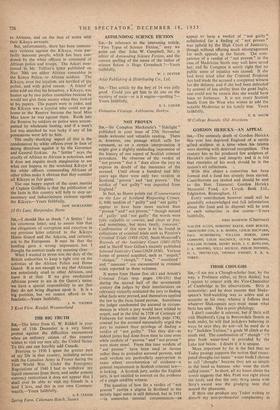NOT PROVEN
SIR,—Sir Compton Mackenzie's " Sidelight " published in your issue of 27th November made welcome and valuable reading. There is, however, one passage which calls for comment, as on a certain interpretation it might give a slightly misleading impression of the history of one aspect of Scottish criminal procedure. He observes of the verdict of " not proven " that it " does allow the jury to express its doubt of the innocence of the accused. Until about a hundred and fifty years ago there were only two verdicts in Scotland, ' proven ', and not proven.' The verdict of ' not guilty' was imported from England."
In fact, as Hume points out (Commentaries on the Law of Scotland Respecting Crimes, ii, 440) verdicts of " guilty " and " not guilty " appear to have been more ancient than " proven " and"' not proven," " though instead of ' guilty' and ' not guilty' the words were ' fylit, culpable or convict, and clean or free, and sometimes, but more rarely, innocent." Confirmation of this view is to be found in collections of criminal trials such as Pitcairn's Criminal Trials (1488-1624), Soott-Moncrieff's Records of the Justiciary Court (1661-1678) and in Sheriff Stair Gillon's recently published Selected Justickiry Cases (1624-1650). Various forms of general acquittal, such as "acquit," " clanget," " clengit," " free," " assoilzied " and " innocent " are encountered in criminal trials reported in these volumes.
it seems from Hume (loc. cit.) and Arnott's Criminal Trials (esp. pages 190-191) that during the second half of the seventeenth century the judges by their interlocutors on relevancy virtually restricted the jury to finding what facts were proved, and themselves applied the law to the facts found proven. Sometimes the judges condemned the accused in circum- stances in which a jury would have wished to acquit, and in the trial in 1728 of Carnegie of Finhaven for murder (see Arnott, page 178), counsel for the accused successfully urged the jury to reassert their privilege of finding a verdict of " not guilty." This they did—as indeed juries had done from time to time even while verdicts of " proven " and " not proven " were niore usual. From this time verdicts of " not proven " have been usecl to favour rather than to prejudice accused persons, and such verdicts are particularly appropriate in cases where corroboration of evidence—a general requirement in Scottish criminal law— is lacking. A Scottish jury, unlike the English jury, is not entitled to convict on the evidence of a single credible witness.'
The question of how far a verdict of " not proven " carries a stigma in Scotland in the strictly legal sense is still debated, but in 1951 —in somewhat unusual circumstances—an appeal to have a verdict of "not guilty" substituted for a finding of " not proven " was upheld by the High Court of Justiciary, though without offering much encouragement for such appeals in the future. 'The com- petence of a verdict of " not proven " in the case of Madeleine Smith may well have saved her, and Sir Compton is surely right that no public sense of injustice was caused. If she had been tried after the Criminal Evidence Act had made the accused a competent witness for the defence, and if she had been defended by counsel of less ability than the great Inglis, one could not be certain that she would have been so fortunate. It is not every Scottish Smith from the West who wishes to add the notable Madeleine to his family tree. Yours faithfully,
T. B. SMITH










































 Previous page
Previous page